Authors - J.-N. Zhou, M.A. Hofman, L.J. Gooren and D.F. Swaab
Source - © NATURE, 378: 68-70 (1995)
Transsexuals have the strong feeling, often from childhood onwards, of having been born the wrong sex. The possible psychogenic or biological etiology of transsexuality has been the subject of debate for many years [1,2]. Here we show that the volume of the central subdivision of the bed nucleus of the stria terminalis (BSTc), a brain area that is essential for sexual behaviour [3,4], is larger in men than in women. A female-sized BSTc was found in male-to-female transsexuals. The size of the BSTc was not influenced by sex hormones in adulthood and was independent of sexual orientation. Our study is the first to show a female brain structure in genetically male transsexuals and supports the hypothesis that gender identity develops as a result of an interaction between the developing brain and sex hormones [5,6].
Investigation of genetics, gonads, genitalia or hormone level of transsexuals has not, so far, produced any results that explain their status [1,2]. In experimental animals, however, the same gonadal hormones that prenatally determine the morphology of the genitalia also influence the morphology and function of the brain in experimental animals in a sexually dimorphic fashion [6,7]. This led to the hypothesis that sexual differentiation of the brain in transsexuals might not have followed the line of sexual differentiation of the body as a whole. In the past few years, several anatomical differences in relation to sex and sexual orientation have been observed in the human hypothalamus (see [6] for a review), but so far no neuroanatomical investigations have been made in relation to the expression of cross-gender identity (transsexuality).
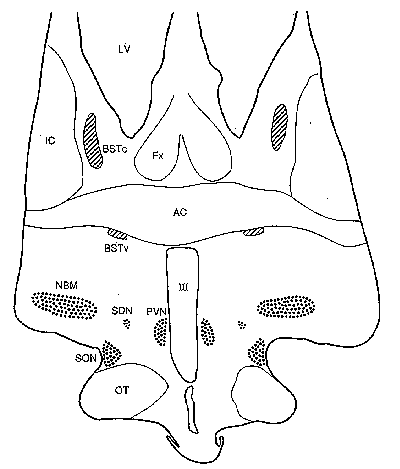
Figure 1: Schematic frontal section through two subdivisions of the bed nucleus of the stria terminalis (BST) that are hatched. III: third ventricle; AC: anterior commissure; BSTc and BSTv: central and ventral subdivisions of the BST; FX: fornix; IC: internal capsule; LV: lateral ventricle; NBM: nucleus basalis of Meynert; OT: optic tract; PVN: paraventricular nucleus; SDN: sexually dimorphic nucleus; SON: supraoptic nucleus.
We have studied the hypothalamus of six male-to-female transsexuals (T1-T6); this material that was collected over the last eleven years. We searched for a brain structure that was sexually dimorphic, but not influenced by sexual orientation, as male-to-female transsexuals may be "oriented" to either sex with respect to sexual behaviour. Our earlier observations showed that the paraventricular nucleus (PVN), sexually dimorphic nucleus (SDN) and suprachiasmatic nucleus (SCN) did not meet these criteria ([6] and unpublished data). Although there is no accepted animal model for gender identity alterations, the bed nucleus of the stria terminalis (BST) turned out to be an appropriate candidate to study for the following reasons. First, it is known that the BST plays an essential part in rodent sexual behaviour [3,4]. Not only have oestrogen and androgen receptors been found in the BST [8,9], it is also a major aromatization centre in the developing rat brain [10]. The BST in the rat receives projections mainly from the amygdala and provides a strong input in the preoptic-hypothalamic region [11,12]. Reciprocal connections between hypothalamus, BST and amygdala are also well documented in experimental animals [13-15]. In addition, sex differences in the size and cell number of the BST have been described in rodents which are influenced by gonadal steroids in development [16-18]. Also in humans a particular caudal part of the BST (BNST-dspm) has been reported to be 2.5 times larger in men than in women [19].
The localization of the BST is shown in figure 1. The central part of the BST (BSTc) is characterized by its somatostatin cells and vasoactive intestinal polypeptide (VIP) innervation [20]. We measured the volume of the BSTc on the basis of its VIP innervation (Fig. 2).
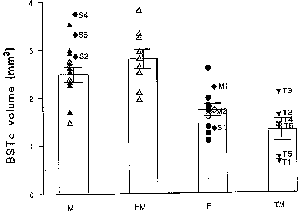
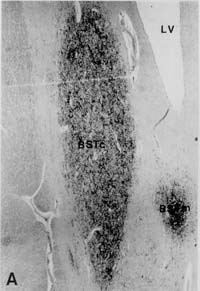
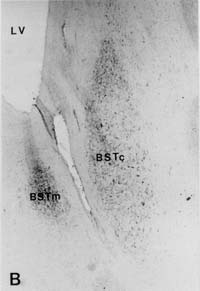
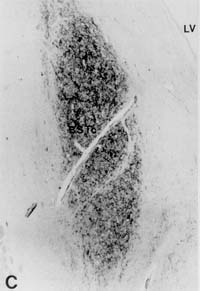
Figure 2: Representative sections of the BSTc innervated by vasoactive intestinal polypeptide (VIP). A: heterosexual man; B: heterosexual woman; C: homosexual man; D: male-to-female transsexual. Bar=0.5 mm. LV: lateral ventricle. Note there are two parts of the BST in A and B: small sized medial subdivision (BSTm), and large oval-sized central subdivision (BSTc).
The BSTc volume in heterosexual men (2.49±0.16 mm3) was 44% larger than in heterosexual women (1.73±0.13 mm3) (P0.15), indicating that the observed small size of the BSTc in transsexuals was not due to the fact that they were, on average, 10 to 13 years older than the hetero- and homosexual men.
The BST plays an essential role in masculine sexual behaviour and in the regulation of gonadotrophin release, as shown by studies in the rat [3,4,21]. There has been no direct evidence that the BST has such a role in human sexual behaviour but our demonstration of a sexually dimorphic pattern in the size of the human BSTc, which is in agreement with the previously described sex difference in a more caudal part of the BST (BNST-dspm) [19], indicates that this nucleus may also be involved in human sexual or reproductive functions. It has been proposed that neurochemical sex differences in the rat BST may be due to effects of sex hormones on the brain during development and in adulthood [22,23]. Our data from humans however, indicate that BSTc volume is not affected by varying sex hormone levels in adulthood. The BSTc volume of a 46-year-old woman who had suffered for at least 1 year from a tumour of the adrenal cortex that produced very high blood levels of androstenedione and testosterone, was within the range of that of other women (Fig. 3: S1). Furthermore, two postmenopausal women (aged over 70 years) showed a completely normal female-sized BSTc (Fig. 3: M1, M2). As all the transsexuals had been treated with oestrogens, the reduced size of the BSTc could possibly have been due to the presence of high levels of oestrogen in the blood. Evidence against this comes from the fact that transsexual T2 and T3 both showed a small, female-like BSTc (Fig. 3), although T2 stopped taking oestrogen about 15 months before death, since her prolactin levels were too high and T3 stopped hormone treatment since a sarcoma was found about three months before death; also a 31-year-old man who suffered from a feminizing adrenal tumour which induced high blood levels of oestrogen, nevertheless had a very large BSTc (Fig. 3: S2).
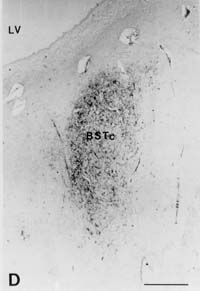
Figure 3: Volume of the BSTc innervated by VIP fibres in presumed heterosexual males (M), homosexual males (HM), presumed heterosexual females (F) and male-to-female transsexuals (TM). The six transsexuals are numbered T1-T6. The patients with abnormal sex hormone levels are numbered S1-S4. M1 and M2: postmenopausal women. Bars indicate mean±SEM. Open symbols: individuals who died of AIDS.
Methods
Brains of 42 subjects matched for age, postmortem time and duration of formalin fixation were investigated. The autopsy was performed following the required permission. For immunocytochemical staining of VIP, the paraffin sections were hydrated and rinsed in TBS (Tris-buffered-saline: 0.05 M tris, 0.9% NaCl, pH 7.6). The sections were incubated with 200 µl anti-VIP (Viper, 18/9/86) 1:1000 in 0.5% triton in TBS overnight at 4° C. The immunocytochemical and morphometric procedures were performed as described extensively elsewhere [25-27]. In brief, serial 6 m m sections of the BSTc were studied by means of a digitizer (Calcomp 2000) connected to a HP-UX 9.0, using a Zeiss microscope equipped with a 2.5x objective and with 10x (PLAN) oculars. Staining was performed on every 50th section with anti-VIP. The rostral and caudal borders of the BSTc were assessed by staining every 10th section in the area. The volume of the BSTc was determined by integrating all the area measurements of the BSTc sections that were innervated by VIP fibres. In a pilot study, the size of the BSTc was measured on both sides in eight subjects (five females and three males) and no left-right asymmetries were observed: the left BSTc (1.71±0.16 mm3) was comparable in size to that of the right BSTc (1.83±0.30 mm3) (P=0.79). No asymmetry was observed in the BNST-dspm either [19]. The rest of our study was therefore performed on one side of the brain only. Brain weight of the male transsexuals (1385±75 g) was not different from that of the reference males (1453±25 g) (P=0.61) or that of the females (1256±35 g) (P=0.23). The cause of death of the six transsexuals was suicide (T1), cardiovascular disease (T2,T6), sarcoma (T3), AIDS, pneumonia, pericarditis (T4) and hepatitic failure (T5). Sexual orientation of the subjects of the reference group (12 men and 11 women) was generally not known, but presumably most of them were heterosexual. Sexual orientation of nine homosexuals was registered in the clinical records [28]. Differences among the groups were tested two-tailed using the Mann-Whitney U test. A 5% level of significance was used in all statistical tests.
Our results might also be explained if the female-sized BSTc in the transsexual group was due to the lack of androgens, because they had all been orchidectomized except for T4. We therefore studied two other men who had been orchidectomized because of cancer of the prostate (one and three months before death: S4 and S3, respectively), and found that their BSTc sizes were at the high end of the normal male range. The BSTc size of the single transsexual who had not been orchidectomized (T4) ranged in the middle of the transsexual scores (Fig. 3). Not only were five of the transsexuals orchidectomized, they all used the antiandrogen cyproterone acetate (CPA). A CPA effect on the BSTc does not seem likely, because T6 had not taken CPA for the past 10 years, and T3 took no CPA during the two years before death and still had a female-sized BSTc.
Results
In summary, our observations suggest that the small size of the BSTc in male-to-female transsexuals cannot be explained by differences in adult sex hormone levels, but is established during development by an organizing action of sex hormones, an idea supported by the fact that neonatal gonadectomy of male rats and androgenization of the female rats indeed induced significant changes in the number of neurons of the BST and suppressed its sexual dimorphism [17,18].
Considered together with information from animals, then our study supports the hypothesis that gender identity alterations may develop as a result of an altered interaction between the development of the brain and sex hormones [5,6]. The direct action of genetic factors should also be considered on the basis of animal experiments [24].
We found no relationship between BSTc size and the sexual orientation of transsexuals, that is, whether they were male-oriented (T1,T6), female-oriented (T3,T2,T5), or both (T4). Furthermore, the size of the BSTc of heterosexual men and homosexual men did not differ, which reinforced the idea that the reduced BSTc size is independent of sexual orientation. In addition, there was no difference in BSTc size between early-onset (T2,T5,T6) and late-onset transsexuals (T1, T3), indicating that the decreased size is related to the gender identity alteration per se rather than to the age at which it becomes apparent. Interestingly, the very small BSTc in transsexuals appears to be a very local brain difference. We failed to observe similar changes in three other hypothalamic nuclei, namely, PVN, SDN or SCN in the same individuals (unpublished data). This might be due to the fact that these nuclei do not all develop at the same time, or to a difference between these nuclei and the BST with respect to the presence of sex hormone receptors or aromatase. We are now studying the distribution of sex hormone receptors and the aromatase activity in various hypothalamic nuclei in relation to sexual orientation and gender.
Acknowledgements
We thank Mr. B. Fisser, Mr. H. Stoffels, Mr. G. van der Meulen, and Ms. T. Eikelboom and Ms. W.T.P. Verweij for their help, and Drs. R.M. Buijs, M.A. Corner, E. Fliers, A. Walter and F.W. van Leeuwen for their comments. Brain material was provided by the Netherlands Brain Bank (coordinator Dr. R. Ravid). This study was supported by NWO.
References
- Money, J. and Gaskin, Int. J. Psychiatry, 9 (1970/1971) 249.
- Gooren, L.J.G., Psychoneuroencrinology, 15 (1990) 3-14.
- Kawakami, M. and Kimura, F., Endocrinol. Jap., 21 (1974) 125-130.
- Emery, D.E. and Sachs, B.D., Physiol. Behav., 17 (1976) 803-806.
- Editorials Lancet, 338 (1991) 603-604.
- Swaab, D.F. and Hofman, M.A., TINS, 18 (1995) 264-270.
- Money, J., Schwartz, M. and Lewis, V.G., Psychoneuroendocrinology, 9 (1984) 405- 414.
- Sheridan, P.J., Endocrinology, 104 (1979) 130-136.
- Commins, D. and Yahr, D., J. Comp. Neurol., 231 (1985) 473-489.
- Jakab, R.L., Horvath, T.L., Leranth, C., Harada, N. and Naftolin, F.J., Steroid Biochem. Molec. Biol., 44 (1993) 481-498.
- Eiden, E.L., Hökfelt, T, Brownstein, M.J. and Palkovits, M., Neuroscience, 15 (1985) 999-1013.
- De Olmos, J.S. In: Paxinos, G. (Ed.), The Human Nervous System, Academic Press, San Diego, 1990, pp. 597-710.
- Woodhams, P.L., Roberts, G.W., Polak, J.M. and Crow, T.J., Neuroscience, 8 (1983) 677-703.
- Simerly, R.B., TINS, 13 (1990) 104-110.
- Arluison, M., et al., Brain Res. Bull., 34 (1994) 319-337.
- Bleier, R., Byne, W. and Siggelkow, I., J. Comp. Neurol., 212 (1982) 118-130.
- Del Abril, A., Segovia, S. and Guillamón, A., Dev. Brain Res., 32 (1987) 295-300.
- Guillamón, A., Segovia, S. and Del Abril, A., Dev. Brain Res., 44 (1988) 281-290.
- Allen, L.A. and Gorski, R.A., J. Comp. Neurol., 302 (1990) 697-706.
- Walter, A., Mai, J.K., Lanta, L. and Görcs, T.J., Chem. Neuroanat., 4 (1991) 281-298.
- Claro, F., Segovia, S., Guilamón, A. and Del Abril, A., Brain Res. Bull., 36 (1995) 1-10.
- Simerly, R.B. and Swanson, L.W., Proc. Natl. Acad. Sci. U.S.A., 84 (1987) 2087- 2091.
- De Vries, G.J., J. Neuroendocrinol., 20 (1990) 1-13.
- Pilgrim, Ch. and Reisert, I., Horm. metab. Res., 24 (1992) 353-359.
- Swaab, D.F., Zhou, J.N., Ehlhart, T. and Hofman, M.A., Brain Res., 79 (1994) 249- 259.
- Zhou, J.N., Hofman, M.A. and Swaab, D.F., Neurobiol. Aging (1995) in press.
- Zhou, J.N., Hofman, M.A. and Swaab, D.F., Brain Res. 672 (1995) 285-288.
- Swaab D.F. and Hofman M.A., Brain Res., 537 (1990) 141-148.
Comments
comments powered by Disqus